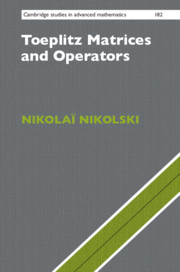Book contents
- Frontmatter
- Dedication
- Contents
- Preface
- Acknowledgements
- Other
- Figures
- 1 Why Toeplitz–Hankel? Motivations and Panorama
- 2 Hankel and Toeplitz: Sibling Operators on the Space H2
- 3 H2 Theory of Toeplitz Operators
- 4 Applications: Riemann–Hilbert, Wiener–Hopf, Singular Integral Operators (SIO)
- 5 Toeplitz Matrices: Moments, Spectra, Asymptotics
- Appendix A Key Notions of Banach Spaces
- Appendix B Key Notions of Hilbert Spaces
- Appendix C An Overview of Banach Algebras
- Appendix D Linear Operators
- Appendix E Fredholm Operators and the Noether Index
- Appendix F A Brief Overview of Hardy Spaces
- References
- Backmatter
- Index
- References
References
Published online by Cambridge University Press: 06 December 2019
- Frontmatter
- Dedication
- Contents
- Preface
- Acknowledgements
- Other
- Figures
- 1 Why Toeplitz–Hankel? Motivations and Panorama
- 2 Hankel and Toeplitz: Sibling Operators on the Space H2
- 3 H2 Theory of Toeplitz Operators
- 4 Applications: Riemann–Hilbert, Wiener–Hopf, Singular Integral Operators (SIO)
- 5 Toeplitz Matrices: Moments, Spectra, Asymptotics
- Appendix A Key Notions of Banach Spaces
- Appendix B Key Notions of Hilbert Spaces
- Appendix C An Overview of Banach Algebras
- Appendix D Linear Operators
- Appendix E Fredholm Operators and the Noether Index
- Appendix F A Brief Overview of Hardy Spaces
- References
- Backmatter
- Index
- References
- Type
- Chapter
- Information
- Toeplitz Matrices and Operators , pp. 395 - 415Publisher: Cambridge University PressPrint publication year: 2020



